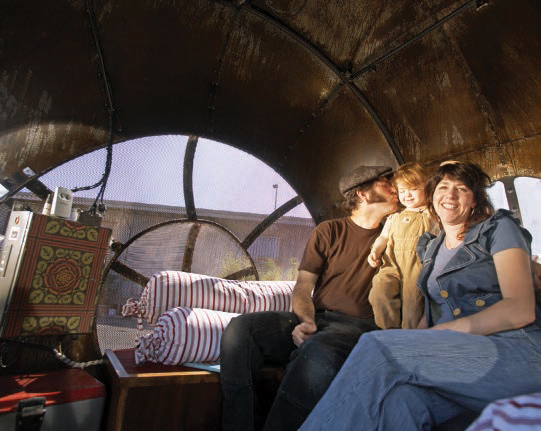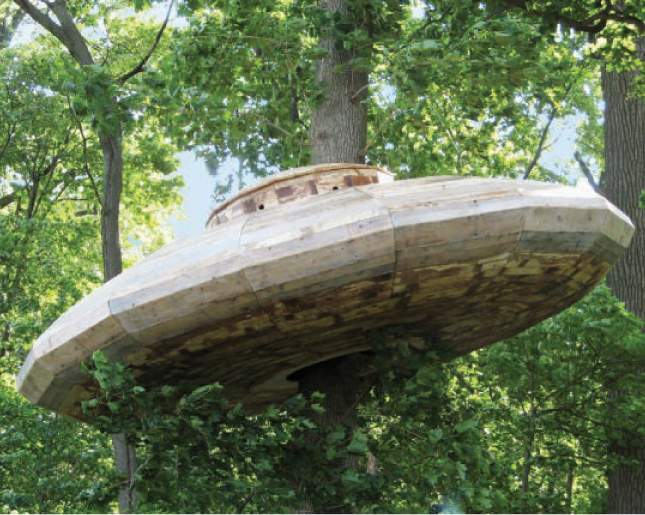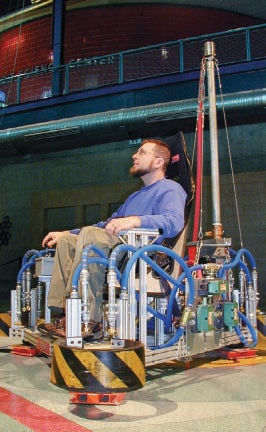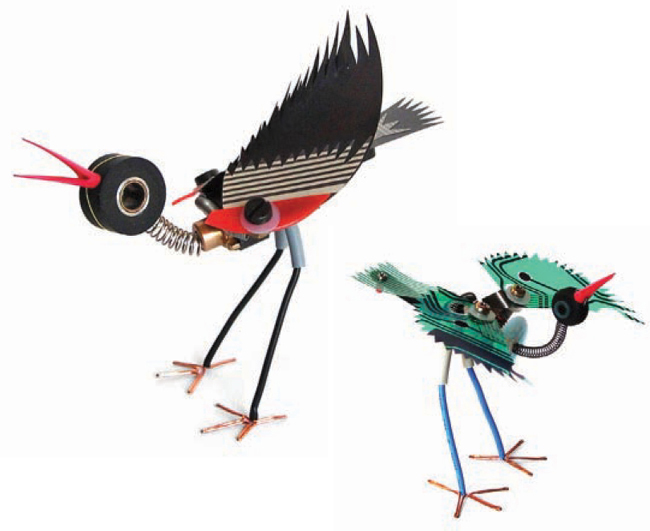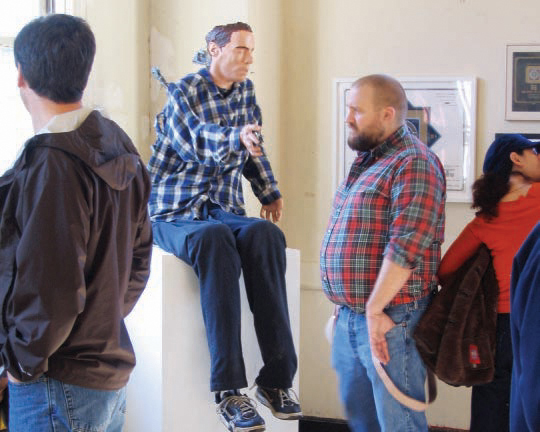MADE ON EARTH
Report from the world of backyard technology
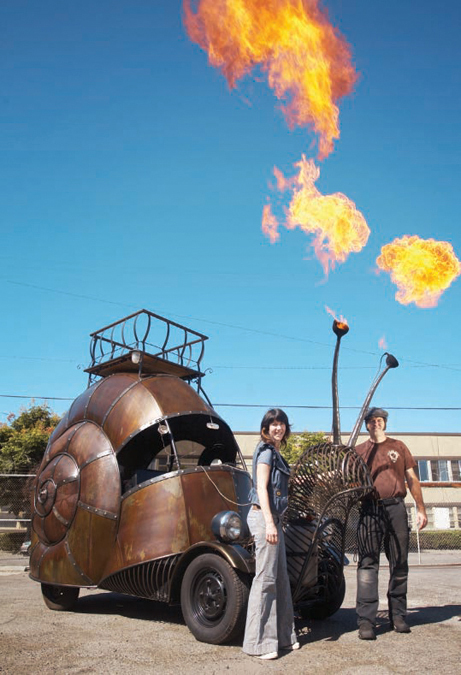
Photography by Branca Nitzsche
Out of Their Shell
Kyrsten Mate drives like a snail. No surprise, though. After all, her car is a snail. Dubbed the Golden Mean, it debuted at this year’s Burning Man festival, where revelers eagerly rode in its glowing shell, or hugged the head with its flamethrower eyes. Every afternoon, Mate’s 2-year-old daughter, Zolie, commandeered the cushioned interior for story time.
“Several years ago, I dreamt that I saw a car in the desert but the car was a giant snail,” says Mate, a sound designer for films like The Incredibles.
And those are the kinds of dreams that stuff is made of. Fortunately, Mate and her husband, blacksmith Jon Sarriugarte, are well versed in weird rides. Their last collaboration was the SS Alpha Fox, a civil service vehicle converted into a fire-spewing spaceship straight out of 1960s science fiction.
The Golden Mean began life as a 60s-era Volkswagen Beetle — inexpensive and easy to transform with their “oil punk” aesthetic. Early plans for the shell called for fiberglass construction, but Sarriugarte wasn’t eager to deal with the mess.
Fortunately, the scrap pile at Sarriugarte’s hand-forged furniture company, Form & Reform, was heaping with possibility. They made an exoskeleton from steel, skinning it in sheet metal and perforated steel to allow a view of the outside world.
Midway through the build, the couple learned about the golden ratio of mathematics, sometimes called the golden mean. The number is found throughout nature, including the proportions of a snail’s shell. They soon took a tape measure to their creation.
“We realized that we had unconsciously already been following the proportion a lot,” Sarriugarte says. “That revelation has given me a whole new insight into how I’d like to make stuff inspired by nature.”
The biomechanical buggy does seem alive. It boasts an air ride suspension that can pump the shell up and down. Other lively mods are in the works.
“We can’t forget the snail trail,” Mate reminds him. That would be a trickle of graywater collected from campsites when the Golden Mean hits the open road.
—David Pescovitz
≫ Golden Mean and More: formandreform.com
Photograph by Scott Haefner USGS
Shake-o-Rama
Kiwi conceptual artist D.V. Rogers likes to shake it. To prove it, he dug a trench 6 feet down near the San Andreas Fault in Parkfield, Calif., population 18.
Into the void he lowered his very own hydraulic shake table, rescued from a defunct mining museum and set to jostle, its earthquake data captured by the U.S. Geological Survey, where Rogers is an artist in residence. Atop the hulking, three-ton slab, he attached an array of 10-foot, 5/8-inch steel rods that oscillate to the Earth’s seismic hum.
The project, Parkfield Interventional EQ Fieldwork — the EQ stands for earthquake — started rumbling in the late 1990s, when the artist, based in Sydney, Australia, acquired the table. A couple of years and 3,000 hours of labor later, Rogers had a modular machine that moved when global earthquakes rattled.
An early installation caught the attention of USGS scientist Andy Michael, who suggested bringing the work to Parkfield, the most heavily monitored part of the globe, seismically speaking, known for withstanding a magnitude 6.0 or greater quake every 22 years or so (the last one was in 2004).
“Earthquakes are in my blood, I guess,” says the cowboy hat-clad Rogers, who’s from Napier, New Zealand, a port city on the North Island leveled by a magnitude 7.9 quake in 1931.
Using software developed by Stock Plum in the Netherlands and Dr. Geo Homsy in Alameda, Calif., PIEQF runs a Python script to isolate California data from the USGS monitoring network. Its I/O card drives a bank of relays that switch solenoid valves and open the gates to hydraulic actuators, allowing the entire table to move horizontally and vertically. The swaying rods above accentuate the table’s movement and that of the ground below.
“The idea is to create a physical representation of a dynamic landscape,” Rogers says at his characteristic lightning clip. “I’m intervening and introducing a human time scale, literally creating a reflector of the geologic time frame we reside in.”
—Megan Mansell Williams
![]() Earthquake Machine: allshookup.org/parkfield
Earthquake Machine: allshookup.org/parkfield
Photograph by Gail Simpson
Avian Spacecraft
It wasn’t your typical crash landing, but, then again, it wasn’t your typical UFO, either. On a wet May day on the outskirts of Philadelphia, Gail Simpson and Aristotle Georgiades forklifted a 500-pound wooden flying saucer 20 feet up into a grove outside the Abington Art Center.
As Georgiades and a helper clambered on top to cable it to a tree, the rain came pelting down. “There was a windstorm, a rainstorm, and the temperature had dropped 20 degrees,” says Simpson. “It was kind of nightmarish.”
The UFO, on the other hand, is anything but. Made from a warm and familiar material — weathered pine boards left over from a turn-of-the-century barn — the sculpture isn’t likely to inspire fear. And eight built-in birdhouses add an inviting touch.
The duo, who go by the name Actual Size Artworks, aimed to give the spacecraft “a really handmade, crazy-carpenter look,” says Simpson, adding that this isn’t a big departure from the Martian ships of the 1950s: “When you look at them in old posters and movies, they do look a little rickety.”
Building the giant donut (the center of the alien ship) was equal parts high tech and handicraft for the two University of Wisconsin-Madison professors, who combined a CAD software design with a lot of fiddly sawing. “The program gives you an idea of size and angles but there’s always human operator error, and the materials were all eccentrically sized,” explains Simpson.
They built an armature of ribbed sections and skinned it with the boards. At 16 feet in diameter, it easily allowed Simpson to slip inside and spend a lot of time there threading bolts through.
“The scale is true to little green men,” says Georgiades.
“It would comfortably house two small aliens,” chimes in Simpson.
“Oh,” counters Georgiades, “it would house four or five.” Not to mention a whole flock of birds.
—Eric Smillie
≫ Larger-Than-Life Sculpture: actualsizeartworks.com
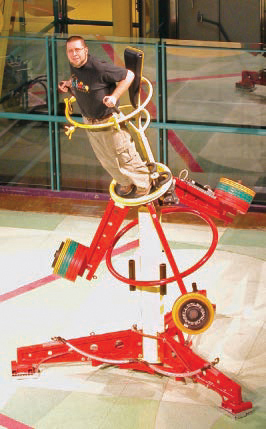
Photography by Tom Luczycki
Gliding on Air
“Nostalgia on steroids” is how Tom Luczycki describes the process he used to build the Air Car. Recalling the personal hovercraft ads he saw as a child in magazines like Boy’s Life, Luczycki set out to build an exhibit to delight children and remind adults of the one device they always wanted to build.
The original model used industrial air casters and a lightweight camp chair to float the rider. The second iteration replaced the camp chair with some additional framework and an aluminum race car seat that added several pounds of mass, but tons more cool.
Then came directional jets. The first version was just a single jet; the rider held a length of hose and operated a ball-valve, which allowed them to get moving pretty quick, but — here’s the kicker — steering and orientation were impossible.
Luczycki’s team wanted the air car to simulate the difficulties of maneuvering in space — weightlessness in 2D — so a more complex system was needed. They came up with an arrangement where the rider manipulates the car via a joystick and a lever switch.
Luczycki first got the maker bug when he worked on the maintenance crew at a paper mill in upstate New York. “When trying to meet a production quota at the end of the month, you saw the most insane, Goldbergian cobb-jobs to keep a machine running for just a few more days,” he recalls. Once the deadline passed, he’d get to see the job done right. He learned that both methods are important, and need to be used together in the right proportions.
After studying engineering, Luczycki switched to fine arts and worked in an art foundry, first as a metal finisher, then as a large-scale sand molder.
Eventually, he landed his dream job as a designer and fabricator at the Detroit Science Center, where he built projects like the Air Car and the Tilt-O-Rama, a ride that elicits two kinds of reactions: the shock and horror of the passengers and the delight of their friends at seeing them in shock and horror.
“The best is when we would put in a teacher who was visiting the center on a field trip,” he says. “The students went nuts.”
—Bruce Stewart
≫ Tom’s Stuff: land-o-lizardo.blogspot.com
Photography by Ann Smith
Technozoology
“I’m in a bird phase,” says Ann Smith of Providence, R.I. The birds in question evoke playfulness and scientific savvy with a meticulous arrangement of mechanical and electronic castoffs, including keyboard mylar and tiny gears from watches.
These fanciful avian miniatures are just the latest creations in her growing mechanical menagerie. Past enthusiasms include bugs, goats, cats, antelopes, frogs, squid, jellyfish, dinos, and more.
Smith’s first robot-like figurine was a horse she made for an illustration assignment at the Rhode Island School of Design. She explains: “The topic of the project was technology and my idea was to make some sort of a Trojan horse of technology: technology being something people invite into their homes that eventually spreads and takes over.”
Both natural and mechanical forms continue to inspire Smith’s work, and the sources of her material are as diverse as the creatures themselves: sewing machines, clocks, computers, keyboards, phones, cameras, printers, typewriters, and other gadgets.
She starts her sculptures by focusing on the structural form of an animal, and then builds onto it, adding texture and detail. “A piece only feels complete when it’s acquired a sense of life and personality,” she says.
The distinctive personalities of her robotic figures have been used as illustrations for advertising and featured in prestigious magazines such as Wired and Architectural Digest (Germany). Her work is also in demand in shops and galleries nationwide.
But her new passion is breathing life into her creations through stop-motion animation. “They have always been alive and running around in my mind, and it is wonderful to see them actually come to life,” she exudes. “Eventually I’d like to start adding narration and sound to the pieces.”
In the meantime, her miniature zoo expands with more colorful and delicate birds. And, her imagination ever alert to possibility, a 3½-foot-long whale.
—Donna Tauscher
≫ Ann Smith’s Sculptures: burrowburrow.com
Photograph by Kal Spelletich
Spying for Kicks
In a panopticon, every prison cell is visible from a central guard tower. No one can get away with anything and so, in theory, everyone behaves. Kalopticon, on the other hand, a life-sized robot created by San Francisco artist Kal Spelletich, invites disorder, and toys with the notion of surveillance.
Spelletich was born in a hospital elevator. At 9, he began tinkering with a chemistry set. He took a construction job as soon as he could hold a hammer, and started rebuilding engines before he had a license. He’s also an actor — think “TV guy” in the 1991 film Slacker. Oh yeah, and there’s his whole art thing: degrees from the University of Iowa and the University of Texas, and lecturer at San Francisco State University.
The artist, whose interactive works include a burning bed that straps a participant in for a backward free-fall, unveiled Kalopticon at the Close Calls: 2008 show in Sausalito, Calif. Spelletich used his own measurements, cast his own face, and dressed his creation in his own duds. But Kalopticon is rude. It kicks, jerks, and turns away just when you lean in for a closer look. Machine malice isn’t at work, though. Cameras in the robot’s mouth and on the ceiling above feed real-time footage to TV monitors 30 feet away, where a joystick lets participants control Kalopticon’s flails.
The installation tickles the Big Brother nerve intentionally, Spelletich says, noting that all over the world, cameras with an eye on the public are increasing.
“Why just let the military and law enforcement play with this stuff?” he asks. “You can use a flamethrower for art. You can play with surveillance art, too. Technology isn’t bad, it’s what you do with it.”
These days, Spelletich is playing with a 12-foot-tall machine that reads brain waves and responds with a hug, and a robot hooked up to leeches.
“I’m a bit of a political animal,” Spelletich says, as if that weren’t obvious. “I find the leech to be a great metaphor for a lot of the problems with the planet and our society.”
—Megan Mansell Williams
![]() Kalopticon in Action: makezine.com/go/kalopticon
Kalopticon in Action: makezine.com/go/kalopticon
≫ Kal Spelletich: seemen.org/kal.html
Photograph courtesy of Malle Hawking
Ship of Bricks
When Malle Hawking watched a documentary about the USS Harry S. Truman, something clicked. He’d built ships out of Lego as a child, so it occurred to him that he’d like to have a model of the American supercarrier. He found his old boxes of Lego in his basement in Munich, Germany, and started building.
After 14 months and countless shipments of parts, his creation was done. “I can’t think of anything else in my life that was so exhausting and challenging,” says Hawking, 38. “And for the costs, I could have had my own Volkswagen instead. But it wouldn’t give me that much fun.”
The ship’s 54 aircraft alone took a whole month to create. There are working lights, movable elevators and radar dishes, even a webcam mounted inside the hull to let viewers see the interior.
Getting the shape of the Truman’s superstructure right proved to be the biggest challenge, as Hawking had only one video and a couple dozen images from the internet.
More than 300,000 bricks were needed to complete the model, with its hull of light gray pieces, and internal, nonvisible elements made up of random colors. The ship is 16 feet long and weighs more than 350 pounds. It can be split into six sections for (relative) ease of transportation. When completed in 2006, it set the world record for largest Lego boat. (It’s big!)
The biggest surprise for Hawking was the enthusiasm that the Truman met with as he began to show it off. It was blogged more than 200 times before he even finished the model. It’s been displayed in Munich, Cologne, Berlin, and the Lego Museum in Billund, Denmark, and this year it appeared in shopping malls around Germany.
Even the U.S. Navy has shown interest. Recently, a deal to ship the model to the United States for display fell through, but Hawking hopes it will happen soon.
—John Baichtal
≫ Lego Aircraft Carrier: makezine.com/go/legoship

